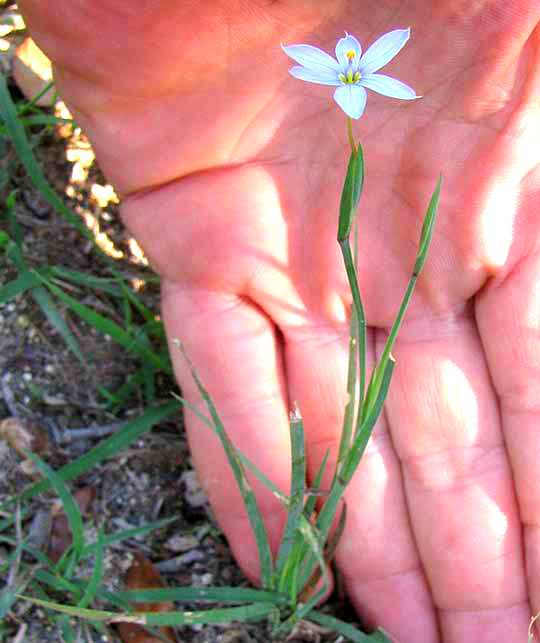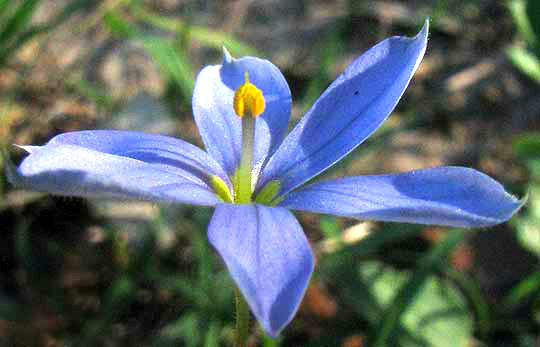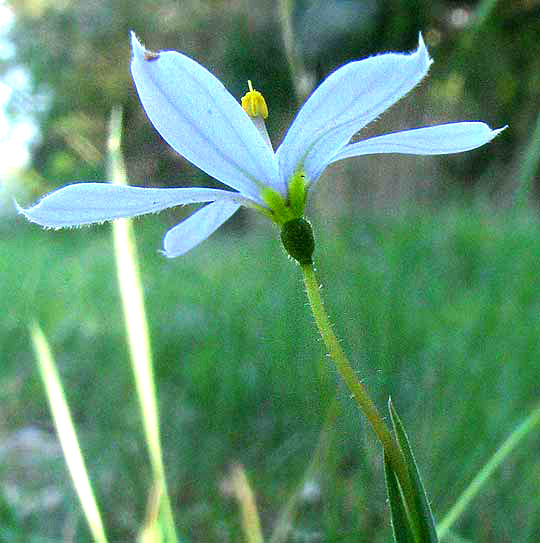Excerpts from Jim Conrad's
Naturalist Newsletter
from the June 9, 2013 Newsletter issued from the Frio Canyon Nature Education Center in northern Uvalde County, southwestern Texas, on the southern border of the Edwards Plateau; elevation ~1750m (~5750 ft); N29.62°, W99.86°; USA
BLUE-EYED GRASS
A delicate little wildflower producing surprising small bursts of blue along roads and in grassy areas in semi-open woods on the hills' lower slopes, only about five inches tall (13cm), is the one shown below:

In that image notice how the blossom arises from two modified leaves, or bracts, shaped like scoops with their sides pressed together, and the upper bract's base fits into the lower one. This arrangement, which contributes to a slightly zigzagging stem, might remind you of how iris flowers do it, and that's appropriate, since this plant is a genuine wild member of the Iris Family.
A close-up of the 7/8ths-inch-across (22mm) blossom is shown below:

A shot of the same flower from below appears below:

Wildflower fanciers nearly everywhere in North America except the far North will recognize this commonly occurring and widely distributed wildflower as a kind of blue-eyed grass, genus Sisyrinchium. You can see that our flower has a yellow eye, not a blue one, and if it's a member of the Iris Family it's certainly not a grass, but that's how common names go.
Anyway, it's easy to recognize blue-eyed grasses, but saying which species of blue-eyed grass you have can be hard, since just in North America we have 37 species (about 80 worldwide), and details distinguishing them often are subtle. Fortunately the unfinished online Flora of North America has its Sisyrinchium section finished. There I could "key out" our plant as SISYRINCHIUM ... *
*UPDATE: "Keying out" the many similar blue-eyed grass species, often with overlapping features, and without seeing good pictures of them is iffy, and in this case I was never quite sure. In 2024, with many more identification resources on the Internet, I now think this must be Narrow-leaved Blue-eyed Grass, SISYRINCHIUM ANGUSTIFOLIUM, mainly occurring in eastern North America and Mexico, but turning up elsewhere, often planted in gardens and sometimes aggressively invasive. Among the species' field marks are its pale blue flowers -- not dark blue -- and its flattish, "winged" stems.
This species' field marks are so technical -- based on variations in features usually not found beyond the Iris Family -- that even readers of this Newsletter might get groggy hearing about them. However, good field marks for blue-eyed grasses in general include the manner by which the usually-blue flowers arise from those pairs of folded-together bracts, the fact that the leaves are flattish in cross-section (not folded, or V-shaped in cross-section, as among the irises), and that most species produce blossoms looking a lot like ours.